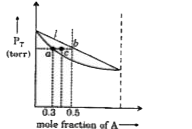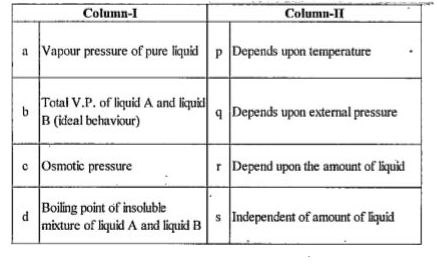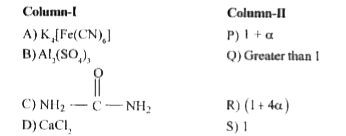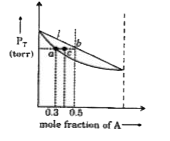Level-III (Statement Type) from BRILLIANT PUBLICATION SOLUTIONS for Class 12
| Class 12 | CHEMISTRY |
| Chapter | SOLUTIONS |
| BRILLIANT PUBLICATION | Level-III (Statement Type) |
| Medium | English |
| Academic Year | 2023-2024 |
Question 2
The mole fraction of liquid A in a binary liquid solution of A (vapour pressure pA=300 Torr) and B (Vapour pressure, pB=800 Torr) is 0.6. The external pressure on this is slowly reduced from 760 Torr. The pressure at which first bubble of vapour appears and the mole fraction of A in this vapour, respectively, are View SolutionQuestion 5
Two liquids X and Y form an ideal solution. At 300K, vapour pressure of the solution containing 1mol of X and 3mol of Y is 550mm Hg. At the same temperature, if 1 mol of Y is further added to this solution, vapour pressure of the solution increases by 10mmHg. Vapour pressure (in mmHg) of X and Y in their pure states will be, respectively.View SolutionQuestion 6
For a dilute solution containing 2.5g of a non -volatile non-electrolyte solute in 100g of water, the elevation in boiling point at 1 atm pressure is 2∘C. Assuming concentration of solute is much lower than the concentration of solvent, the vapour pressure (mm of Hg) of the solution at 100∘C is (take Kb=0.76kgmol−1)View SolutionQuestion 40
1 mole of A and 1 mole B are mixed together to form an ideal solution at 25∘C. Solution is placed in a vessel fitted with piston. If pressure on the solution is reduced isothermally.

Composition of first vapour formed from liquid mixture with xA=0.5 will have mole fraction of yAandyB in the vapour phase areView SolutionQuestion 45
The osmotic pressure π depends on the molar concentration of the solution (π=CRT). If two solutions are of equal solute concentration and, hence, have the same osomotic pressure, they are said to be isotonic. If two solutions are of unequal oxmotic pressure, the more concentrated solution is said to be hypertonic and the more diluted solution is described as hypotonic. Osmosis is the major mechanism for transporting water upward in the plants. Answer the following questions
A plant cell shrinks when it is kept inView SolutionQuestion 46
The osmotic pressure π depends on the molar concentration of the solution (π=CRT). If two solutions are of equal solute concentration and, hence, have the same osomotic pressure, they are said to be isotonic. If two solutions are of unequal oxmotic pressure, the more concentrated solution is said to be hypertonic and the more diluted solution is described as hypotonic. Osmosis is the major mechanism for transporting water upward in the plants. Answer the following questions
What would be the percent strength of solution of urea that would be isotonic with 4.5% solution of glucose ? View SolutionQuestion 47
The osmotic pressure π depends on the molar concentration of the solution (π=CRT). If two solutions are of equal solute concentration and, hence, have the same osomotic pressure, they are said to be isotonic. If two solutions are of unequal oxmotic pressure, the more concentrated solution is said to be hypertonic and the more diluted solution is described as hypotonic. Osmosis is the major mechanism for transporting water upward in the plants. Answer the following questions
The glucose solution to be injected into the bloodstream and the blood itself should have same.View SolutionQuestion 48
The vapour pressure of two pure liquids A and B which form an ideal solution are 300 and 800 torr, respectively, at temperature T. A liquid solution of A and B for which the mole fraction of A is 0.60 is contained in a cylinder closed by piston on which the pressure can be varied. The solution is slowly vapourized at temperature T by decreasing the applied pressure, starting with a pressure of about 1 atm. Based on this information, answer the following questions
The composition of the first bubble of vapour will beView SolutionQuestion 49
The vapour pressure of two pure liquids A and B which form an ideal solution are 300 and 800 torr, respectively, at temperature T. A liquid solution of A and B for which the mole fraction of A is 0.60 is contained in a cylinder closed by piston on which the pressure can be varied. The solution is slowly vapourized at temperature T by decreasing the applied pressure, starting with a pressure of about 1 atm. Based on this information, answer the following questions
The composition of the last droplet of liquid will beView SolutionQuestion 50
The vapour pressure of two pure liquids A and B which form an ideal solution are 300 and 800 torr, respectively, at temperature T. A liquid solution of A and B for which the mole fraction of A is 0.60 is contained in a cylinder closed by piston on which the pressure can be varied. The solution is slowly vapourized at temperature T by decreasing the applied pressure, starting with a pressure of about 1 atm. Based on this information, answer the following three questions
The pressure of the vapour when the last droplet of liquid remains will beView Solution
All Exercises from BRILLIANT PUBLICATION Class 12 CHEMISTRY SOLUTIONS
- QUESTION (LEVEL -I) (HOMEWORK)
- QUESTIONS
- LEVEL I
- LEVEL-I
- QUESTION (LEVEL -II)
- QUESTION (LEVEL -II) (ASSERTION-REASON)
- LEVEL II
- LEVEL II (ASSERTION & REASON TYPE)
- LEVEL-II
- LEVEL -III (SINGLE CORRECT ANSWER TYPE)
- LEVEL-III (LINKED COMPREHENSION TYPE)
- LEVEL-III (MATCHING COLUMN TYPE)
- LEVEL-III (MULTIPLE CORRECT ANSWER TYPE)
- LEVEL-III (NUMERICAL TYPE)
- LEVEL-III (STATEMENT TYPE)







